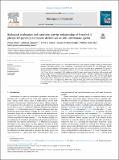Files in this item
Biological evaluation and structure activity relationship of 9-methyl-1-phenyl-9H-pyrido[3,4-b]indole derivatives as anti-leishmanial agents
Item metadata
| dc.contributor.author | Ashok, Penta | |
| dc.contributor.author | Chander, Subhash | |
| dc.contributor.author | Smith, Terry K. | |
| dc.contributor.author | Prakash Singh, Rajnish | |
| dc.contributor.author | Nath Jha, Prabhat | |
| dc.contributor.author | Sankaranarayanan, Murugesan | |
| dc.date.accessioned | 2019-02-21T17:30:05Z | |
| dc.date.available | 2019-02-21T17:30:05Z | |
| dc.date.issued | 2019-03 | |
| dc.identifier | 256718894 | |
| dc.identifier | 7d003a6e-9552-44dd-89a5-3bde9bec5709 | |
| dc.identifier | 85057154209 | |
| dc.identifier | 000458112400010 | |
| dc.identifier.citation | Ashok , P , Chander , S , Smith , T K , Prakash Singh , R , Nath Jha , P & Sankaranarayanan , M 2019 , ' Biological evaluation and structure activity relationship of 9-methyl-1-phenyl- 9H -pyrido[3,4-b]indole derivatives as anti-leishmanial agents ' , Bioorganic Chemistry , vol. 84 , pp. 98-105 . https://doi.org/10.1016/j.bioorg.2018.11.037 | en |
| dc.identifier.issn | 0045-2068 | |
| dc.identifier.other | RIS: urn:D159E211DCFAE45974990C6BE28CB55B | |
| dc.identifier.uri | https://hdl.handle.net/10023/17124 | |
| dc.description | One of the authors, Ashok Penta, acknowledges Council of Scientific and Industrial Research, New Delhi, India for financial support in the form of Senior Research Fellowship. This work was also partially supported by TKS’s Welcome Trust project grant 093228 and the European Community’s Seventh Framework Program under grant agreement No.602773 (Project KINDRED). | en |
| dc.description.abstract | A series of piperazinyl-β-carboline-3-carboxamide derivatives were designed through a molecular hybridization approach. Designed analogues were synthesized, characterized and evaluated for anti-leishmanial activity against Leishmania infantum and Leishmania donovani. In L. infantum inhibition assay, compounds 7d, 7g and 7c displayed potent inhibition of promastigotes (EC50 1.59, 1.47 and 3.73 µM respectively) and amastigotes (EC50 1.4, 1.9 and 2.6 µM respectively). SAR studies revealed that, para substitution of methoxy, chloro groups and methyl group on ortho position favored anti-leishmanial activity against L. infantum. Among these analogues 7d, 7h, 7n and 7g exhibited potent inhibition against L. donovani promastigotes (EC50 0.91, 4.0, 4.57 and 5.02 µM respectively), axenic amastigotes (EC50 0.9, 3.5, 2.2 and 3.8 µM respectively) and intracellular amastigotes (EC50 1.3, 7.8, 5.6 and 6.3 µM respectively). SAR studies suggested that, para substitution of methoxy group, para and meta substitution of chloro groups and benzyl replacement recommended for significant anti-leishmanial against L. donovani. | |
| dc.format.extent | 881126 | |
| dc.language.iso | eng | |
| dc.relation.ispartof | Bioorganic Chemistry | en |
| dc.subject | Molecular hybridization | en |
| dc.subject | Leishmaniasis | en |
| dc.subject | Promastigotes | en |
| dc.subject | Amastigotes | en |
| dc.subject | QD Chemistry | en |
| dc.subject | QH301 Biology | en |
| dc.subject | T-DAS | en |
| dc.subject.lcc | QD | en |
| dc.subject.lcc | QH301 | en |
| dc.title | Biological evaluation and structure activity relationship of 9-methyl-1-phenyl-9H-pyrido[3,4-b]indole derivatives as anti-leishmanial agents | en |
| dc.type | Journal article | en |
| dc.contributor.sponsor | The Wellcome Trust | en |
| dc.contributor.sponsor | European Commission | en |
| dc.contributor.institution | University of St Andrews. School of Biology | en |
| dc.contributor.institution | University of St Andrews. Biomedical Sciences Research Complex | en |
| dc.identifier.doi | https://doi.org/10.1016/j.bioorg.2018.11.037 | |
| dc.description.status | Peer reviewed | en |
| dc.identifier.grantnumber | 093228/Z/10/Z | en |
| dc.identifier.grantnumber | 602773 | en |
This item appears in the following Collection(s)
Items in the St Andrews Research Repository are protected by copyright, with all rights reserved, unless otherwise indicated.

